Figure 4.—
Evolution of RAG1 and RAG2 in Xenopus. The RAG1 and RAG2 heterodimer is depicted as a scissor and the evolutionary trajectory of this heterodimer is followed through the reticulate phylogeny that is depicted in Figure 3, including degeneration and deletions of paralogs encoding each protein that are depicted in Figure 2. Proteins encoded by paralogs inherited from diploid ancestor α are yellow-green and those encoded by paralogs inherited from diploid ancestor β are blue. Numbered deletion and degeneration events from Figure 2 are labeled and the ploidy of each ancestor or extant species (2x, 4x, 8x, or 12x) is indicated inside each box. Species and ancestors for which simulations were performed are indicated by a red box. As a result of biased degeneration of RAG1, heterodimers of many extant species must form between proteins that were ultimately inherited from different diploid species (i.e., the scissor is composed of a yellow-green RAG1 protein and a blue RAG2 protein). Single asterisks indicate a minimum of seven independently evolved chimerical heterodimers. Double asterisks indicate caveats that X. cf. fraseri had no observed degeneration of RAG1 paralog β, but that only a small fragment of this paralog was sequenced (supplemental Figure 2 at http://www.genetics.org/supplemental/), and that expression of paralog β was not detected in X. muelleri but no degeneration was observed in the coding region.

